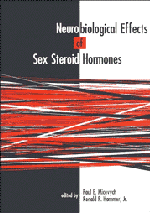Book contents
- Frontmatter
- Contents
- List of contributors
- Dedication
- Preface
- Acknowledgments
- Part I Sex steroid–responsive circuits regulating male and female reproductive behaviors
- Part II Sex steroid interactions with specific neurochemical circuits
- Part III Cellular and molecular mechanisms regulated by sex steroids
- 12 Neurosteroids and neuroactive steroids
- 13 Estrogen synthesis and secretion by the songbird brain
- 14 Neurobiological regulation of hormonal response by progestin and estrogen receptors
- 15 Molecular actions of steroid hormones and their possible relations to reproductive behaviors
- 16 Effects of sex steroids on the central nervous system detected by the study of Fos protein expression
- 17 Developmental interactions of estrogens with neurotrophins and their receptors
- 18 Sex steroid influences on cell–cell interactions in the magnocellular hypothalamoneurohypophyseal system
- Index
16 - Effects of sex steroids on the central nervous system detected by the study of Fos protein expression
Published online by Cambridge University Press: 15 October 2009
- Frontmatter
- Contents
- List of contributors
- Dedication
- Preface
- Acknowledgments
- Part I Sex steroid–responsive circuits regulating male and female reproductive behaviors
- Part II Sex steroid interactions with specific neurochemical circuits
- Part III Cellular and molecular mechanisms regulated by sex steroids
- 12 Neurosteroids and neuroactive steroids
- 13 Estrogen synthesis and secretion by the songbird brain
- 14 Neurobiological regulation of hormonal response by progestin and estrogen receptors
- 15 Molecular actions of steroid hormones and their possible relations to reproductive behaviors
- 16 Effects of sex steroids on the central nervous system detected by the study of Fos protein expression
- 17 Developmental interactions of estrogens with neurotrophins and their receptors
- 18 Sex steroid influences on cell–cell interactions in the magnocellular hypothalamoneurohypophyseal system
- Index
Summary
The presence of specific steroid receptors in neurons and evidence of steroid binding provide a basis for understanding the direct effects of steroids on neuronal function. Yet many key actions of gonadal steroids may be transmitted through multisynaptic pathways, in which only a subset of the participants are directly steroid-sensitive. The exploration of steroid actions on multisynaptic neuronal systems is nonetheless important but has been complicated by the lack of experimental techniques for monitoring activity changes across brain areas. In recent years, scientists have recognized that Fos, the protein product of the c-fos immediate early gene, is expressed in neurons that are stimulated. Immunocytochemical staining of Fos following specific stimuli has proved valuable for assessing neuronal activity (Morgan and Curran 1989; Sagar et al. 1988), and the results of studies using this approach will be presented here.
Specifically, the studies summarized in this chapter examined certain effects of gonadal steroids on neuronal activity as assessed by Fos staining. Two principal lines of investigation will be discussed. The first is the role of estrogen and progesterone in the luteinizing hormone–releasing hormone (LHRH) neuron activation that drives the preovulatory LH surge. The second is the role of progesterone in modifying neuronal activation by excitatory amino acids in brain systems other than the LHRH neurons. The latter studies point to the global effects that gonadal steroid hormones can have on neuronal function distinct from their actions on the regulation of reproductive function.
- Type
- Chapter
- Information
- Neurobiological Effects of Sex Steroid Hormones , pp. 363 - 390Publisher: Cambridge University PressPrint publication year: 1995
- 2
- Cited by



